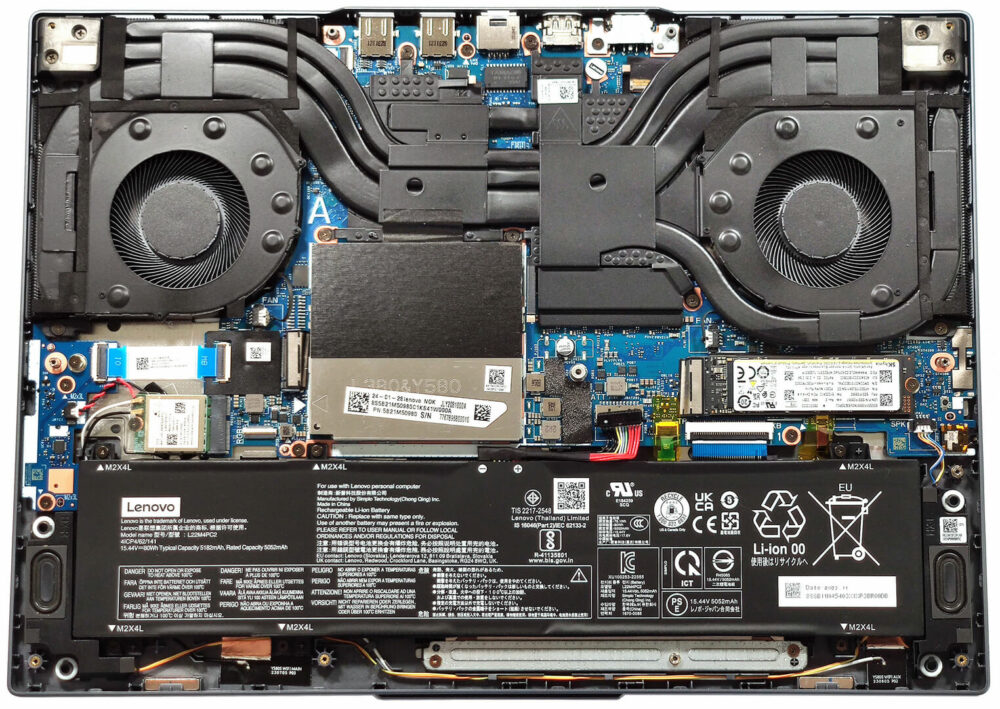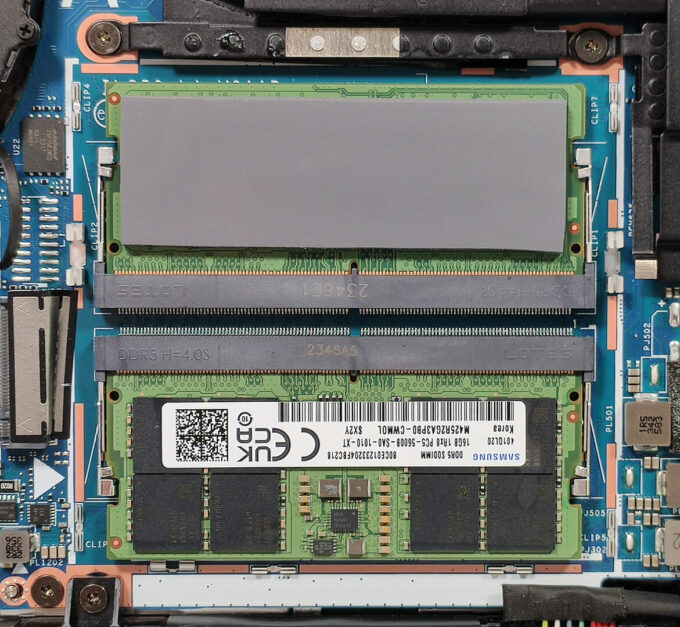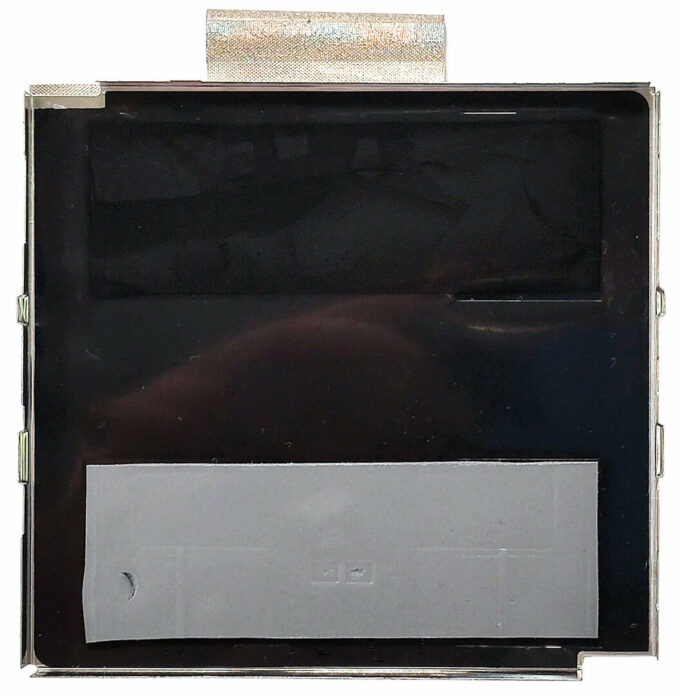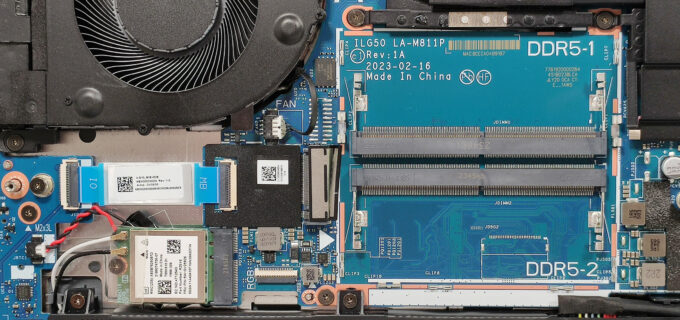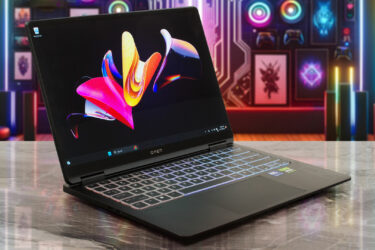Lenovo Legion Slim 5 (16, Gen 9) review – The Good, the Warm, and the Powerful
 Thin gaming laptops are a specific niche of machine for people who need a device with gaming capabilities that don’t weigh a ton. The Legion Slim 5 (16, Gen 9) is part of Lenovo’s Slim lineup. The manufacturer states that their creation is suitable for “gamers and students”. Perhaps these days people need a lot of power for educational purposes. Yep, this notebook relies on the new Hawk Point-HS AMD Zen 4 chip called AMD Ryzen 7 8845HS. This means 16 threads and a TDP of 45W. The maximum possible GPU option for the series is the 140W GeForce RTX 4070 and we bought a device with this graphics card to see how good the cooling is when it’s pushed to its limits.
Thin gaming laptops are a specific niche of machine for people who need a device with gaming capabilities that don’t weigh a ton. The Legion Slim 5 (16, Gen 9) is part of Lenovo’s Slim lineup. The manufacturer states that their creation is suitable for “gamers and students”. Perhaps these days people need a lot of power for educational purposes. Yep, this notebook relies on the new Hawk Point-HS AMD Zen 4 chip called AMD Ryzen 7 8845HS. This means 16 threads and a TDP of 45W. The maximum possible GPU option for the series is the 140W GeForce RTX 4070 and we bought a device with this graphics card to see how good the cooling is when it’s pushed to its limits.
Specs-wise, all looks great – good upgradability, modern port selection, and an LA1 AI Chip that can dynamically tune the CPU and GPU power limits depending on the load. All the standard gaming features are here – a backlit keyboard, a MUX switch, and Wi-Fi 6E + Bluetooth 5.3 for connectivity.
There is no sign of 1080p or Full HD+ displays, yay! You can choose between two 1600p IPS models that offer G-Sync and FreeSync Premium support. The 165Hz variant is tied with NVIDIA Advanced Optimus. The 240Hz unit lacks this feature but it boats DisplayHDR 400 functionality.
You can check the prices and configurations in our Specs System: https://laptopmedia.com/series/lenovo-legion-slim-5-16-gen-9/
Contents
Specs, Drivers, What’s in the box
- HDD/SSD
- up to 4000GB SSD
- RAM
- up to 64GB
- OS
- Windows 11 Home, Windows 11 Pro
- Battery
- 80Wh
- Dimensions
- 359.7 x 260.5 x 19.9 - 25.2 mm (14.16" x 10.26" x 0.78")
- Weight
- 2.30 kg (5.1 lbs)
- Ports and connectivity
- 1x USB Type-A
- 3.2 Gen 2 (10 Gbps)
- 1x USB Type-A
- 3.2 Gen 2 (10 Gbps), Sleep and Charge
- 1x USB Type-C
- 3.2 Gen 2 (10 Gbps), DisplayPort
- 1x USB Type-C
- 3.2 Gen 2 (10 Gbps), Power Delivery (PD), DisplayPort
- HDMI
- 2.1 (8K@60Hz)
- Card reader
- SD (SD, SDHC, SDXC)
- Ethernet LAN
- 10, 100, 1000 Mbit/s
- Wi-Fi
- 802.11ax
- Bluetooth
- 5.2
- Audio jack
- 3.5mm Combo Jack
- Features
- Fingerprint reader
- Web camera
- HD / FHD with E-shutter, fixed focus
- Backlit keyboard
- Microphone
- Dual Microphone Array
- Speakers
- 2x 2W Stereo Speakers, Nahimic Audio
- Optical drive
- Security Lock slot
All Lenovo Legion Slim 5 (16″, Gen 9) configurations
Drivers
All drivers and utilities for this notebook can be found here: https://pcsupport.lenovo.com/us/en/products/laptops-and-netbooks/ideapad-s-series-netbooks/legion-slim-5-16ahp9/downloads/driver-list
What’s in the box?
In the package, you’ll find the laptop itself, a bit of paperwork, and a 170W or 230W barrel plug charger (or an optional additional 140W Type-C adapter). The Lenovo Legion Gaming Speed Mouse Pad and the Legion M300 RGB Gaming Mouse are region-dependent goodies.
Design and construction
No surprises here, the design of the Legion Slim 5 (16, Gen 9) isn’t that different compared to some of its other siblings like the Lenovo Legion 5i (16, Gen 9) but here, you get side vents. The aluminum lid feels stable when it’s closed and the rigidity is alright in an opened position. The plastic base is (almost) solid – there is a tiny amount of flex below the keyboard when you apply pressure on purpose. Perhaps, most users will not spot that during normal usage. The laptop weighs around 2.30 kilos and the profile thickness is 19.9-21.9 mm. So, yes, this machine is actually thin for such a powerhouse.
The anodized finish isn’t a fingerprint magnet. The lid opens smoothly with a single hand – the hinge mechanism feels spot-on.
The bezels around the 1600p display is notably thin. The “hump” on the lid houses a 720p or an optional 1080p Web camera with an E-shutter switch placed on the right side of the laptop.
The maximum angle of opening is super close to the 180-degree mark.
The power button is positioned in the center of the ventilation grill above the keyboard. The latter is a well-known unit that glows in a white color or you can opt for a 4-Zone RGB backlight. We definitely like the big Arrow keys and the NumPad section. The keyboard is suitable for both typing and gaming – the key travel is long and the feedback is clicky.
The Mylar touchpad with a size of 75 x 120 mm is okay for work – the smoothness is average but the accuracy is good.
The bottom plate is business as usual – three rubber feet, two speaker cutouts, and a big ventilation grill. The heat is being exhausted through four vents – two on the rear and two on the sides.
Ports
On the left, you can see two USB Type-C 3.2 (Gen. 2) ports with DisplayPort 1.4 functionality (the latter supports 140W PowerDelivery) and an Audio combo jack. The rear houses two USB Type-A 3.2 (Gen. 2) ports (the latter has an Always On function), LAN, HDMI 2.1 for up to 8K 60Hz external displays, and a power plug. On the right side, you can spot an E-shutter switch and an SD Card reader.
Display and Sound Quality, Get our Profiles
Lenovo Legion Slim 5 (16″, Gen 9) is equipped with a WQXGA (Wide Quad Extended Graphics Array) IPS panel, model number BOE NE160QDM-NYC (BOE0B38). It comes with a 165Hz refresh rate. Its diagonal is 16.0″ (40.6 cm), and the resolution – 2560 x 1600p. Additionally, the screen ratio is 16:10, the pixel density – 189 ppi, and their pitch – 0.13 x 0.13 mm. The screen can be considered Retina when viewed from at least 46 cm (from this distance, the average human eye can’t see the individual pixels).
Viewing Angles
Viewing angles are good. We offer images from different angles to evaluate the quality.
Also, a video with locked focus and exposure.
Brightness and Contrast
The maximum measured brightness is 405 nits (cd/m2) in the middle of the screen and 376 nits (cd/m2) average across the surface with a maximum deviation of 14%. The Correlated Color Temperature on a white screen and at maximum brightness is 7060K (average).
In the illustration below you can see how the display performs from a uniformity perspective. The illustration below shows how matters are for operational brightness levels (approximately 140 nits) – in this particular case at 61% Brightness (White level = 142 cd/m2, Black level = 0.12 cd/m2).
Values of dE2000 over 4.0 should not occur, and this parameter is one of the first you should check if you intend to use the laptop for color-sensitive work (a maximum tolerance of 2.0 ).
The contrast ratio is good – 1180:1.
Color Coverage
Here’s an illustration (Fig. 1). The whole “sail-shaped” map below consists of all the colors we can see, while the black crooked line shows all the colors from real-world scenes and nature around us.
Then, we’ve drawn some of the most important and interesting color spaces, compared to the colors the panel of Lenovo Legion Slim 5 (16″, Gen 9) can show:
Standard/For Web: sRGB – widely used color space for most consumer devices, ideal for Web design and development
For Print: AdobeRGB – used in professional photo editing, graphic design, and print
For Photographers/Video Editors: DCI-P3 – used in high-end film production, post-production, and digital cinema
Premium HDR: Rec.2020 – the widest consumer ITU color standard, covering a massive 75.8% of the visible spectrum, a benchmark for premium HDR content
Lenovo Legion Slim 5 (16″, Gen 9): the yellow dashed triangle (– – – – – –) represents the range of colors this monitor can display. In our tests, we calculated the total color coverage of the monitor at 98% of the sRGB color gamut and 80% of the DCI-P3 color gamut.
(Fig.1) Lenovo Legion Slim 5 (16″, Gen 9) covers 98% of the Web colors (sRGB)
Color Accuracy
Now let’s see how big is the difference between the real colors and the one you’ll see on the Lenovo Legion Slim 5 (16″, Gen 9). We measure that distance in DeltaE – the bigger the number, the more different they look.
For the next illustration, we’ve chosen 24 common colors like dark and light skin, blue sky, green grass, etc.
Values below 2.0 are considered suitable for color-sensitive work. Before our calibration of the Lenovo Legion Slim 5, the Average color accuracy was 3.3 dE (Fig. 2), and with our Design and Gaming profile, it lowered to 1.0 dE (Fig. 3). This is an INCREDIBLE increase in accuracy – more than 3X better! In other words, the laptop is more than ready for Creator work.
Comparison in the sRGB color space (primaries and D65 white point specified in ITU-R BT.709, sRGB encoding curve).
Here’s an illustration of what the Design and Gaming profile aims to deliver:
Left: No Profile | Drag the slider to see the difference | Right: Design & Gaming Profile


The next figure shows how well the display is able to reproduce really dark parts of an image, which is essential when watching movies or playing games in low ambient light.
The left side of the image represents the display with stock settings, while the right one is with the “Gaming and Web Design” profile activated. On the horizontal axis, you will find the grayscale, and on the vertical axis – the luminance of the display. On the two graphs below you can easily check for yourself how your display handles the darkest nuances but keep in mind that this also depends on the settings of your current display, the calibration, the viewing angle, and the surrounding light conditions.
Response time (Gaming capabilities)
We test the reaction time of the pixels with the usual “black-to-white” and “white-to-black” method from 10% to 90% and vice versa.
We recorded Fall Time + Rise Time = 7.6 ms. Short pixel response time is a prerequisite for a smooth picture in dynamic scenes. Gamers should be happy.
After that, we test the reaction time of the pixels with the usual “Gray-to-Gray” method from 50% White to 80% White and vice versa between 10% and 90% of the amplitude.
Health Impact: PWM (Screen flickering)
Pulse-width modulation (PWM) is an easy way to control monitor brightness. When you lower the brightness, the light intensity of the backlight is not lowered, but instead turned off and on by the electronics with a frequency indistinguishable to the human eye. In these light impulses, the light/no-light time ratio varies, while brightness remains unchanged, which is harmful to your eyes. You can read more about that in our dedicated article on PWM.
Lenovo Legion Slim 5 (16″, Gen 9)’s display doesn’t flicker at any brightness level. This makes the screen comfortable for long periods of use.
Health Impact: Blue light emissions
Installing our Health-Guard profile not only eliminates PWM but also reduces the harmful Blue Light emissions while keeping the colors of the screen perceptually accurate. If you’re not familiar with the Blue light, the TL;DR version is – emissions that negatively affect your eyes, skin, and your whole body. You can find more information about that in our dedicated article on Blue Light.
Health Impact: Gloss-level measurement
Glossy-coated displays are sometimes inconvenient in high ambient light conditions. We show the level of reflection on the screen for the respective laptop when the display is turned off and the measurement angle is 60° (in this case, the result is 49.6 GU).
Sound
Lenovo Legion Slim 5’s speakers produce sound of a very high quality. Its low, mid, and high tones have no deviations from clarity.
Buy our profiles
Since our profiles are tailored for each individual display model, this article and its respective profile package are meant for Lenovo Legion Slim 5 (16″, Gen 9) configurations with 16.0″ BOE NE160QDM-NYC (BOE0B38) (2560×1600) IPS.
*Should you have problems with downloading the purchased file, try using a different browser to open the link you’ll receive via e-mail. If the download target is a .php file instead of an archive, change the file extension to .zip or contact us at [email protected].
Read more about the profiles HERE.
In addition to receiving efficient and health-friendly profiles, by buying LaptopMedia's products you also support the development of our labs, where we test devices in order to produce the most objective reviews possible.

Office Work
Office Work should be used mostly by users who spend most of the time looking at pieces of text, tables or just surfing. This profile aims to deliver better distinctness and clarity by keeping a flat gamma curve (2.20), native color temperature and perceptually accurate colors.

Design and Gaming
This profile is aimed at designers who work with colors professionally, and for games and movies as well. Design and Gaming takes display panels to their limits, making them as accurate as possible in the sRGB IEC61966-2-1 standard for Web and HDTV, at white point D65.

Health-Guard
Health-Guard eliminates the harmful Pulse-Width Modulation (PWM) and reduces the negative Blue Light which affects our eyes and body. Since it’s custom tailored for every panel, it manages to keep the colors perceptually accurate. Health-Guard simulates paper so the pressure on the eyes is greatly reduced.
Get all 3 profiles with 33% discount
Performance: CPU, GPU, Storage
All benchmarks and tests were conducted with the “Performance” profile activated plus the “GPU Overclock” function is turned on in the Lenovo Vantage app. Also, the “dGPU-only” mode is selected in the Lenovo software. In addition, the “Best Performance” preset is applied in the Windows “Power & Battery” menu.

CPU options
Currently, the AMD Ryzen 7 8845HS is the only CPU model available for the Legion Slim 5.
Results are from the Cinebench R23 CPU test (the higher the score, the better)
Results are from our Photoshop benchmark test (the lower the score, the better)
GPU options
As for the GPU, you can choose between NVIDIA GeForce RTX 4050 (Laptop, 100W), GeForce RTX 4060 (Laptop, 140W), and GeForce RTX 4070 (Laptop, 140W).
Results are from the 3DMark: Time Spy (Graphics) benchmark (higher the score, the better)
Results are from the 3DMark: Fire Strike (Graphics) benchmark (higher the score, the better)
Results are from the 3DMark: Wild Life benchmark (higher the score, the better)
Results are from the Unigine Superposition benchmark (higher the score, the better)
Gaming tests

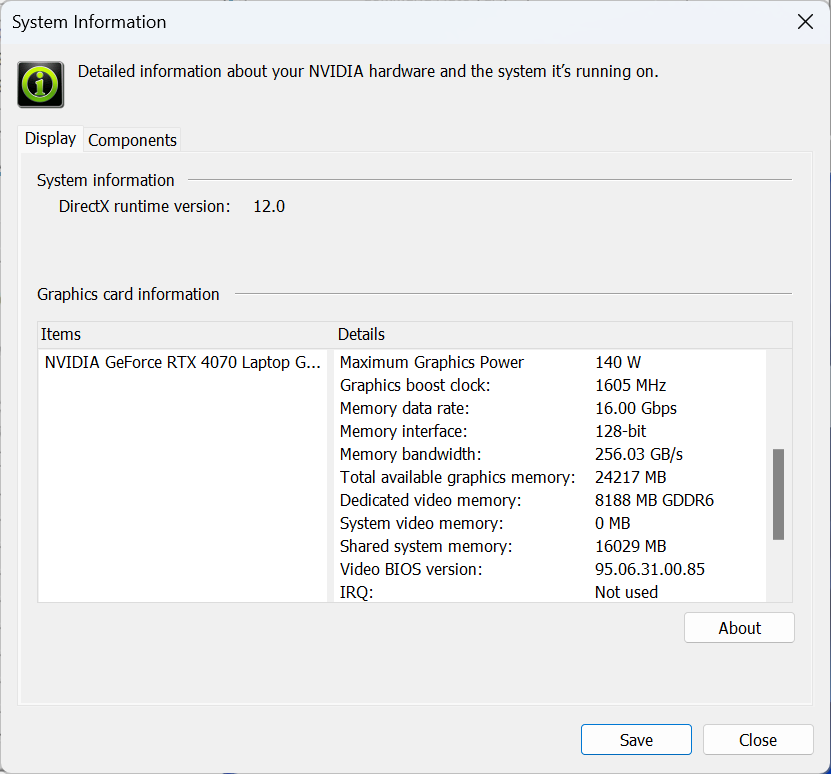
| Metro Exodus | Full HD, Low (Check settings) | Full HD, High (Check settings) | Full HD, Extreme (Check settings) |
|---|---|---|---|
| Average FPS | 183 fps | 109 fps | 53 fps |
| Borderlands 3 | Full HD, V.Low (Check settings) | Full HD, Medium (Check settings) | Full HD, High (Check settings) | Full HD, Badass (Check settings) |
|---|---|---|---|---|
| Average FPS | 151 fps | 135 fps | 123 fps | 105 fps |
| Far Cry 6 | Full HD, Low (Check settings) | Full HD, High (Check settings) | Full HD, Ultra (Check settings) |
|---|---|---|---|
| Average FPS | 131 fps | 111 fps | 104 fps |
| Gears 5 | Full HD, Low (Check settings) | Full HD, Medium (Check settings) | Full HD, High (Check settings) | Full HD, Ultra (Check settings) |
|---|---|---|---|---|
| Average FPS | 221 fps | 177 fps | 163 fps | 145 fps |
The 140W version of the GeForce RTX 4070 (Laptop) is able to show some good scores in Metro Exodus. Interestingly, the ASUS TUF Gaming F16 FX607 (2024) with an RTX 4060 performs better in the other three titles (excluding Borderlands 3 on “Badass” quality).
Storage performance
Our laptop has a 1TB SK Hynix HFS001TEJ9X115N. This fast Gen 4 NVMe reached 70°C during benchmarking.
Temperatures and comfort, Battery Life
Max CPU load
In this test we use 100% on the CPU cores, monitoring their frequencies and chip temperature. The first column shows a computer’s reaction to a short load (2-10 seconds), the second column simulates a serious task (between 15 and 30 seconds), and the third column is a good indicator of how good the laptop is for long loads such as video rendering.
Average core frequency (base frequency + X); CPU temp.
| AMD Ryzen 7 8845HS (45W TDP) | 0:02 – 0:10 sec | 0:15 – 0:30 sec | 10:00 – 15:00 min |
|---|---|---|---|
| Lenovo Legion Slim 5 (16″, Gen 9) | 4.78 GHz @ 92°C @ 123W | 4.73 GHz @ 100°C @ 119W | 4.59 GHz @ 100°C @ 88W |
The Ryzen 7 8845HS is no joke with its 8 cores and 16 threads. Here, this chip can sustain high clocks even in prolonged periods of max CPU stress. Unfortunately, that comes at a price – 100°C temperature.
Real-life gaming
| NVIDIA GeForce RTX 4070 | GPU frequency/ Core temp (after 2 min) | GPU frequency/ Core temp (after 30 min) |
|---|---|---|
| Lenovo Legion Slim 5 (16″, Gen 9) | 2580 MHz @ 81°C @ 130W | 2580 MHz @ 86°C @ 132W |
| Acer Predator Helios Neo 18 (PHN18-71) | 2610 MHz @ 77°C @ 131W | 2610 MHz @ 82°C @ 134W |
| Lenovo Legion Pro 5i (16″, Gen 9) | 2535 MHz @ 74°C @ 129W | 2535 MHz @ 75°C @ 130W |
| Acer Nitro 17 (AN17-41) “Turbo” preset | 2535 MHz @ 66°C @ 121W | 2535 MHz @ 67°C @ 122W |
| Acer Nitro 17 (AN17-41) “Performance” preset | 2475 MHz @ 72°C @ 123W | 2475 MHz @ 73°C @ 123W |
The GeForce RTX 4070 can maintain 2580 MHz and 132W after half an hour of gaming – great! Still, the core temperature is on the high side – 86°.
Comfort during full load
That’s a Lenovo gaming laptop and expectedly you get three performance presets plus a “Custome Mode” in the Lenovo Vantage software. During gaming, the fans are loud (in “Performance” mode). In this scenario, the center of the keyboard feels a bit warm but that’s comfortable enough for work.
For the best possible battery life, the “Hybrid iGPU-only” mode is the way to go. If the charger is connected, the” dGPU-only” mode will unleash the full potential of the graphics card.
The “Performance” preset boasts ~132W TGP (plus a 110°C memory temperature, yikes!), and this value is reduced to just 75W if you switch to the “Balance” mode. The “Quiet” preset offers low noise but the 65W GPU TGP isn’t suitable for heavy gaming since the core clocks are heavily decreased.
In Auto mode, the max possible fan speed is 3500 RPM. For better cooling, you can manually set the fans to 5000 RPM.
Battery
We conducted the battery tests with the Windows Better performance setting turned on, screen brightness adjusted to 120 nits, and all other programs turned off except for the one we are testing the notebook with.
The battery of this laptop is an 80Wh unit that lasts for around 11 hours of Web browsing or 10 hours of video playback. That’s a good result for such a powerful machine! To achieve that, you have to select the “Balance” preset, turn on the “Adaptive Refresh Rate” function, and select the iGPU-only mode in the Lenovo Vantage app. Also, apply the “Balanced” preset in the Windows “Power & Battery” menu.
In order to simulate real-life conditions, we used our own script for automatic web browsing through over 70 websites.
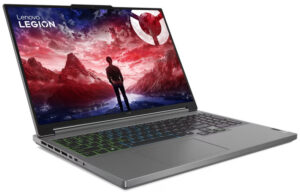
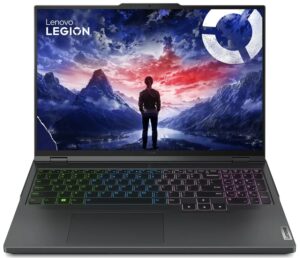
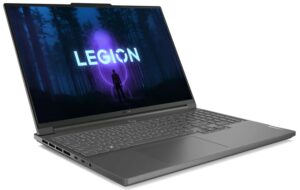

For every test like this, we use the same video in HD.




Disassembly, Upgrade options, and Maintenance
To see the internals, you have to undo 10 Phillips-head screws. After that, pry the panel with a thin plastic tool starting from the front. Then, work your way around the sides and the rear. Just a quick reminder that you have to insert the tool horizontally in between the plate and the base and lift it up to pop the panel.
On the inside of the bottom plate, we can spot two thermal pads for cooling the SSDs.
The battery here is an 80Wh model. To remove it, pull out the connector from the motherboard and undo the 6 Phillips-head screws that fix the unit in place. The capacity is enough for around 11 hours of Web browsing or 10 hours of video playback.
The memory zone is protected by a metal plate and you will need a lever tool to pop the shield. Beneath it, we found two thermal pads that make contact with the RAM modules. According to Lenovo, the two SODIMMs support up to 64GB of DDR5-5600MHz RAM in dual-channel mode. However, since the CPU can support up to 256GB, this laptop likely wouldn’t have issues running a larger amount of memory than the official manufacturer’s specified limit.
For storage, there are two M.2 slots for Gen 4 SSDs.
The sizable cooling has two large fans and three heat pipes shared between the CPU and the GPU, the lower pipe is extra thick. Another pipe is solely dedicated to the graphics card. Additionally, there are four heat sinks and two heat spreaders, the bigger one is on the GPU side.
Verdict
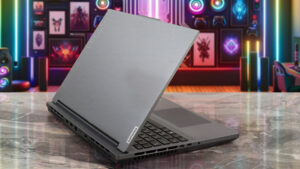 At the end of the day, Lenovo Legion Slim 5 (16, Gen 9) is a powerhouse that is also thin (for a gaming gadget). The chassis is solid and the keyboard is comfortable for gaming or typing. Of course, a not-so-thick profile combined with high-end hardware leads to high noise levels during gaming in “Performance” mode. The fans don’t spin that aggressively when the “Balance” preset is applied but the GPU TGP is reduced from 132W to just 75W.
At the end of the day, Lenovo Legion Slim 5 (16, Gen 9) is a powerhouse that is also thin (for a gaming gadget). The chassis is solid and the keyboard is comfortable for gaming or typing. Of course, a not-so-thick profile combined with high-end hardware leads to high noise levels during gaming in “Performance” mode. The fans don’t spin that aggressively when the “Balance” preset is applied but the GPU TGP is reduced from 132W to just 75W.
Interestingly, the overall power is good but in some gaming titles, the RTX 4070 isn’t showing its full potential (like Far Cry 6 or Gears 5). Perhaps Lenovo could fix this issue with future updates(but maybe the CPU is the bottleneck since some scores on Low or Medium details are too low). The things that can raise a few eyebrows are the high GPU memory and NVMe temperature during benchmarking. The CPU also reaches 100°C in medium and long 100% stress. Aside from that, the both processor and video card can sustain high clocks.
The 165Hz 1600p IPS panel is a real gem! It reaches a maximum brightness of 405 cd/m2 and it boasts snappy pixel response times. Moreover, the 98% sRGB coverage and the great color accuracy when our “Design and Gaming” profile is applied means that you can use the laptop for professional photo and video editing.
The port selection is modern and the upgradability is good – two SODIMMs and two Gen 4 M.2 slots. The battery life is fine for an 80Wh capacity alongside a high-res screen – around 11 hours of Web browsing on a single charge.
You can check the prices and configurations in our Specs System: https://laptopmedia.com/series/lenovo-legion-slim-5-16-gen-9/
Pros
- Long battery life
- Zen 4 CPU
- Solid build
- Modern port selection
- PWM-free (BOE NE160QDM-NYC (BOE0B38))
- 98% sRGB coverage + great color accuracy when our “Design and Gaming” profile is applied (BOE NE160QDM-NYC (BOE0B38))
- 165Hz refresh rate and 1600p resolution (BOE NE160QDM-NYC (BOE0B38))
- The fans aren’t too noisy in “Balance” mode
- Has an optional 1080p Web camera with an E-shutter
- High CPU and GPU clocks during long loads
- Comfortable keyboard
- Supports NVIDIA G-SYNC and Advanced Optimus (BOE NE160QDM-NYC (BOE0B38))
- Has a MUX switch
Cons
- Plastic body
- In some games, the RTX 4070 performance isn’t optimal
- High CPU and NVMe temperatures during benchmarking

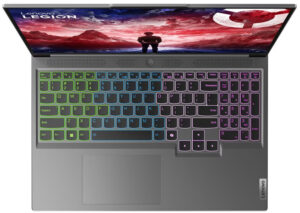
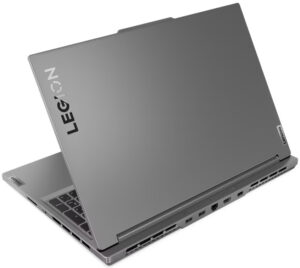

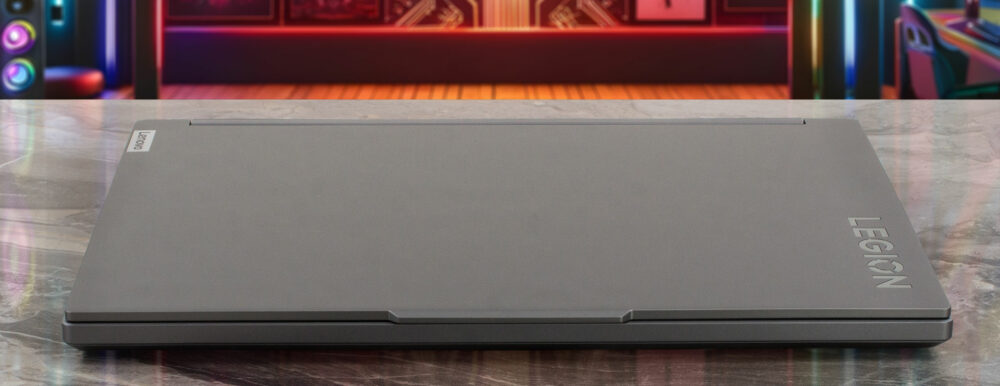


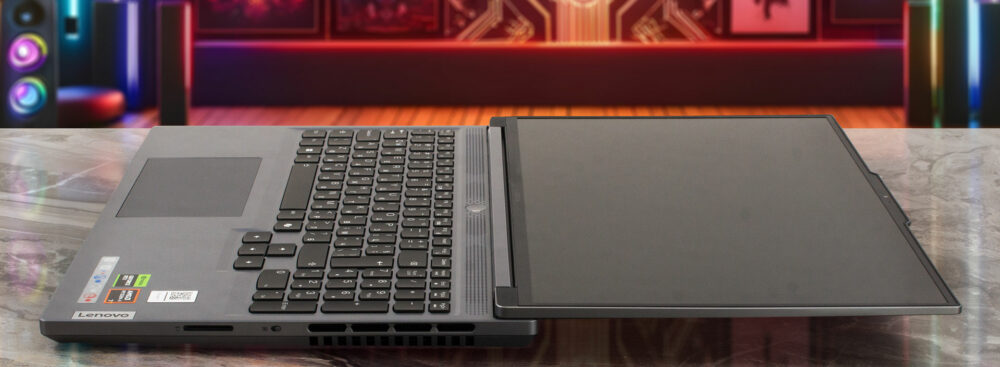
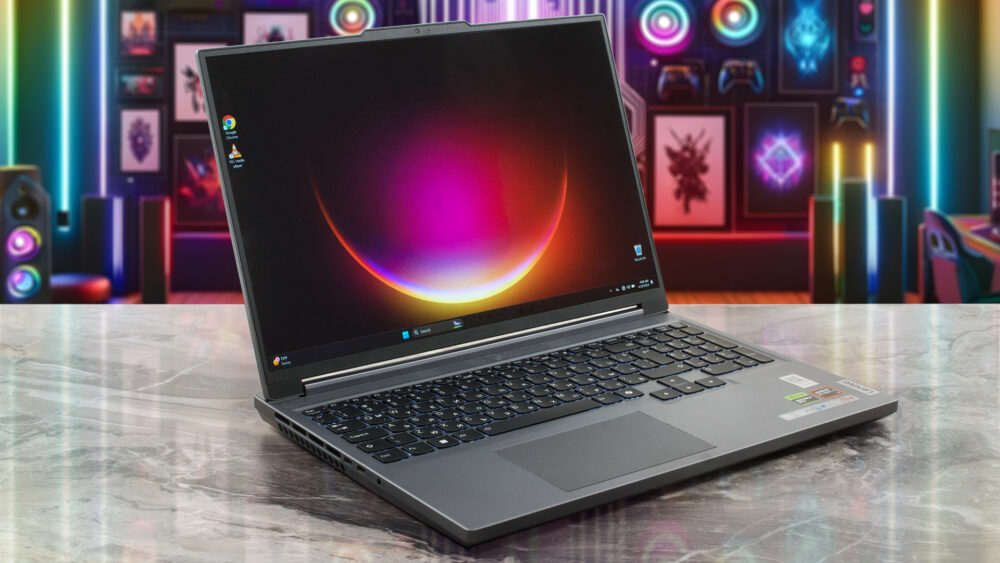


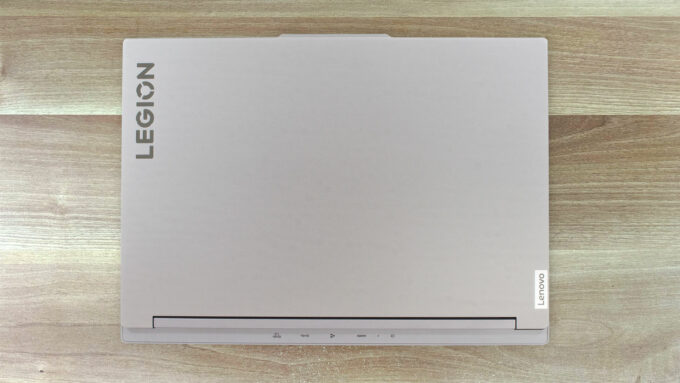





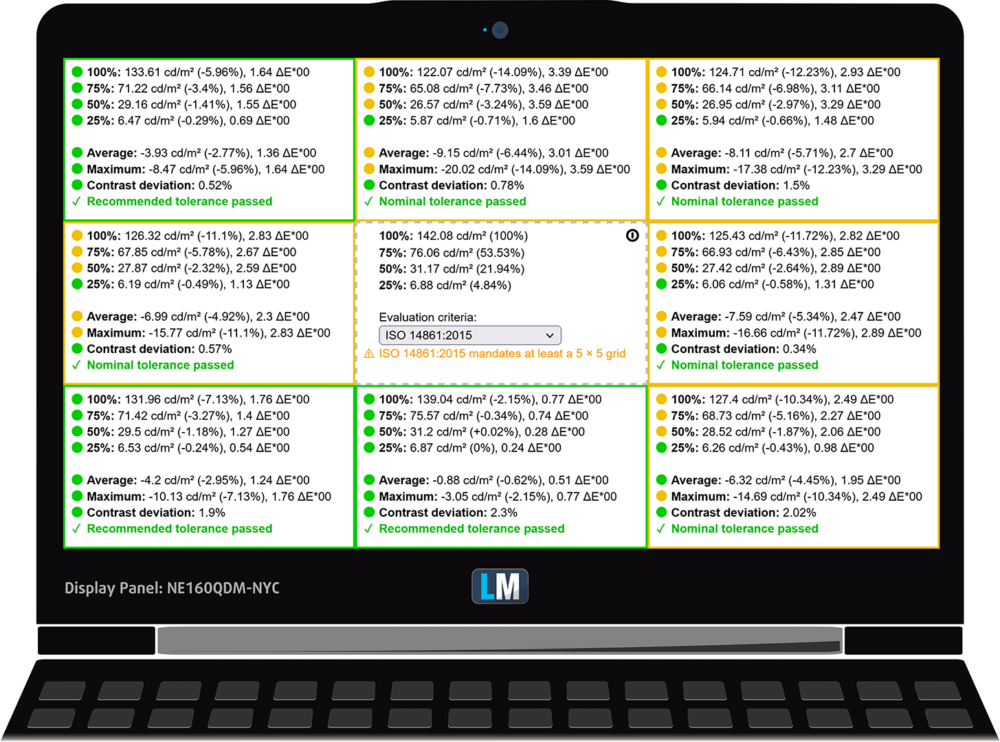

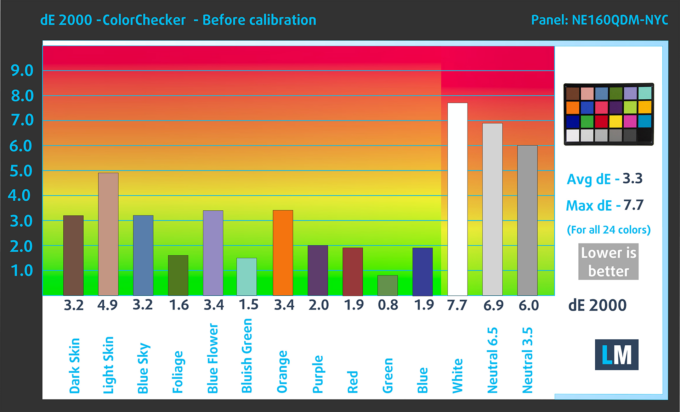
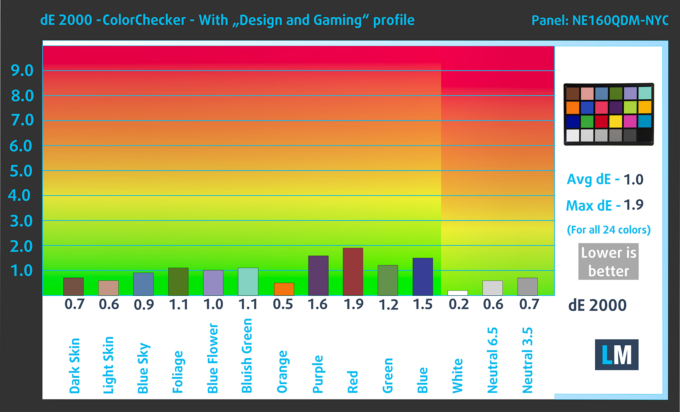

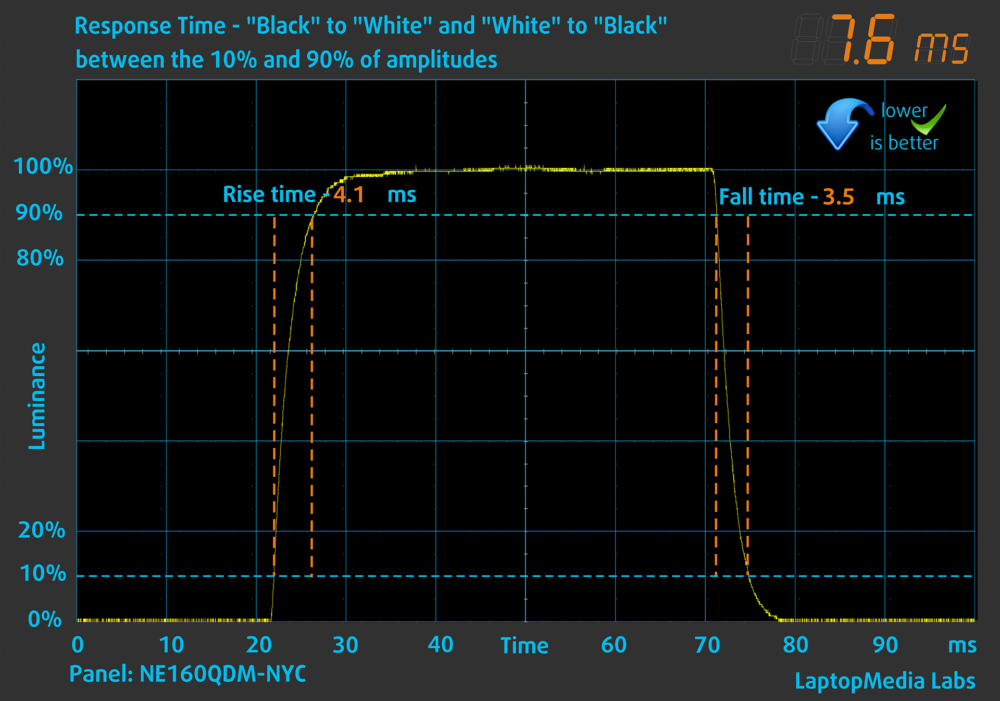
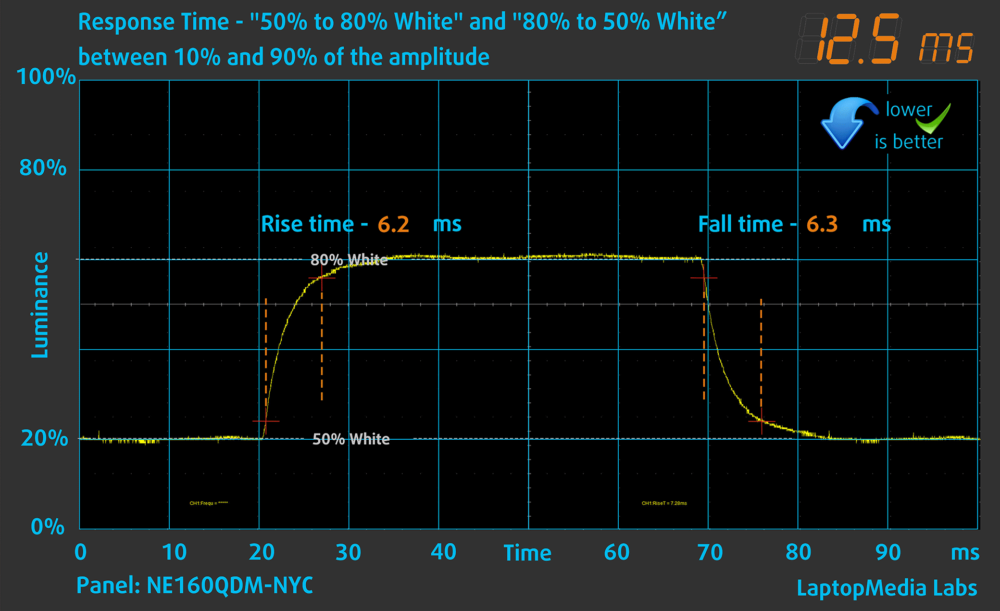

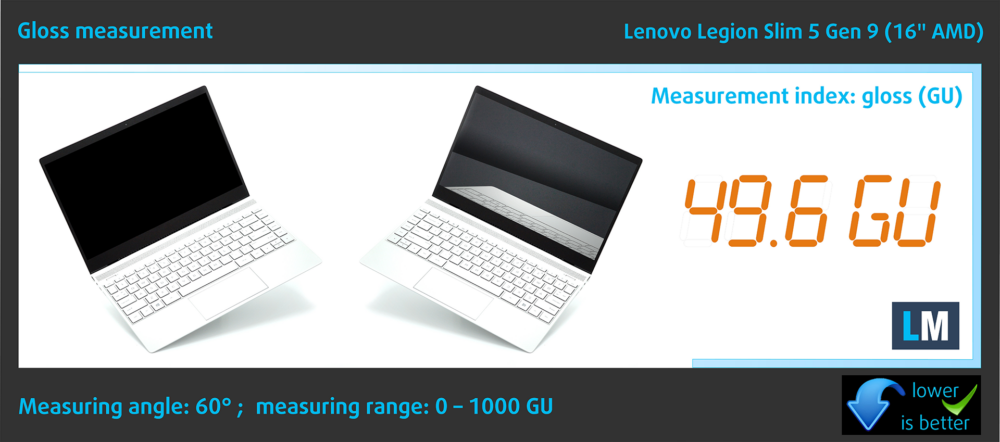



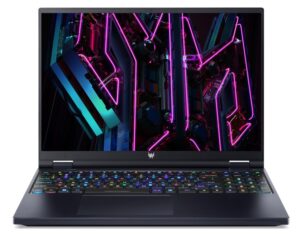




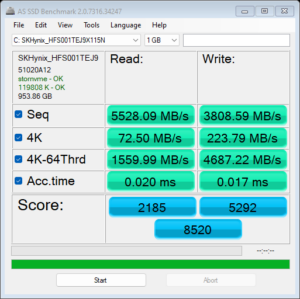

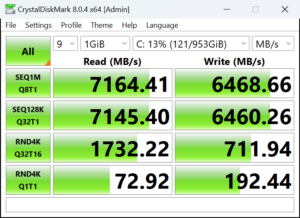

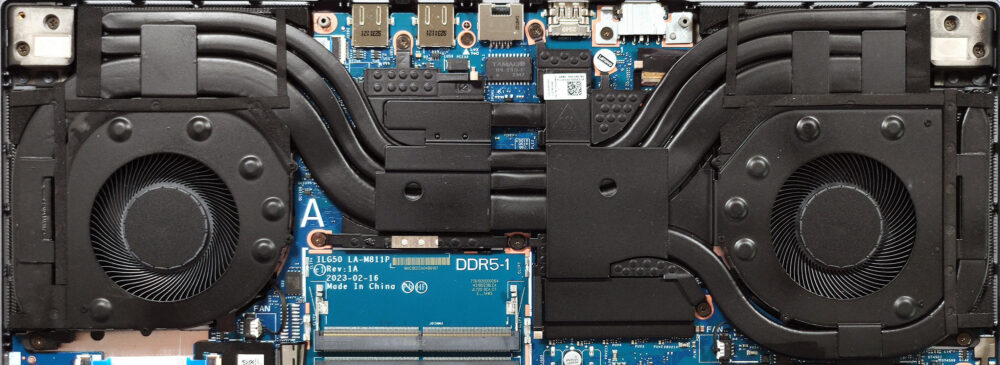



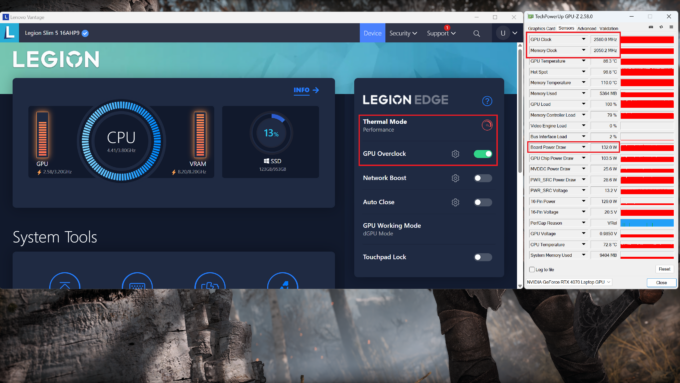 Gaming “Performance”
Gaming “Performance” Gaming “Balance”
Gaming “Balance” Gaming “Quiet”
Gaming “Quiet”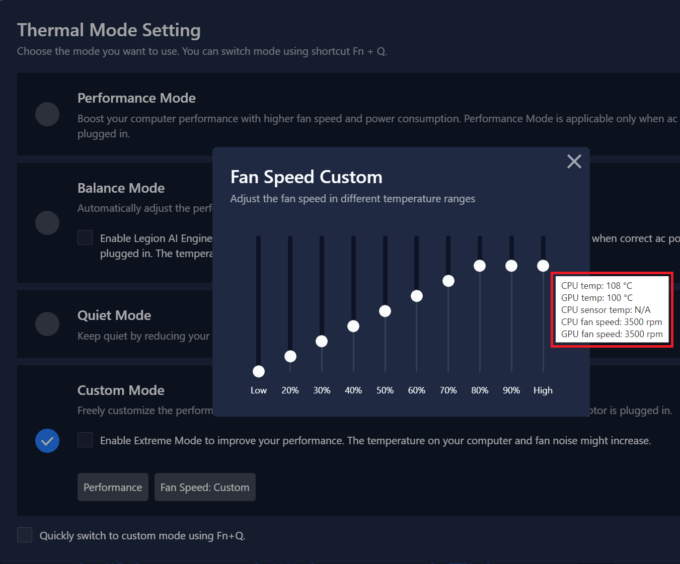 Auto Max Fan Speed
Auto Max Fan Speed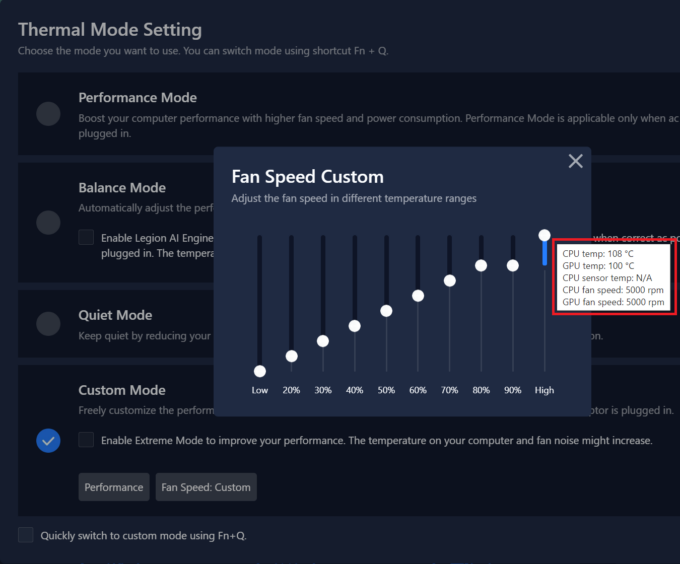 Manual Max Fan Speed
Manual Max Fan Speed

